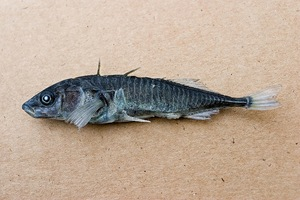
In this post I'll look at the example of the stickleback fish, a small fish characterised by three little spines attached to its pelvis (right) which it can push out to counter predators, essentially turning it into a swimming pincushion. This was a very useful trait as you could imagine. However, over time the stickleback population began to move into more freshwater regions, where their spikes were a disadvantage as large insects like dragonflies could just pluck them out of the water by their sticking out spikes. As you would expect, the spiky sticklebacks began to die out and through natural selection a species of stickleback without the spiky pelvis began to emerge and thrive in the freshwater regions.
This is simple enough to understand on a basic level, but we can dig deeper. How did the stickleback lose its pelvis in the first place? Evolutionary biologist David Kingsley of Stanford University has researched into this question thoroughly and has come back with very convincing results. What he managed to do was isolate the stickleback's gene which was responsible for the production of the pelvis. What he found was that this gene is present not only in the marine sticklebacks with the pelvis, but also the freshwater sticklebacks.
What we can tell from this is that even though both types of fish have the same gene, there is something turning off that gene in the freshwater population - a kind of switch. These gene switches control when a gene is turned on and in what places. So as it turns out, it is not the genes themselves which are mutating, but the gene switches. As a result of this we find very different species can have very similar gene patterns, it's just that some of those genes are switched on or off.

It's likely that this is why we sometimes see mutations in the
human DNA that reveal parts of our ancestry, such as tails (yes, they do happen).
We share 99% of our genes with apes. Yet how do we look so different? The mutations needed for these changes are so so small, but can make such a huge difference in appearance. In my next blog post I might go into how the human brain actually evolved to be so much bigger than the ape brain.
It is all down to tiny mutations.
So what do you think guys, should I have been an evolutionary biologist?

Yes!
ReplyDeleteWow, the part with the tails on humans was quite interesting! I'll be following you're blog more often!
ReplyDeleteFollow mine too :P
This comment has been removed by the author.
ReplyDeleteI'm curious about the photo of the person who seems to have a tail. What I've read repeatedly elsewhere states that no humans have an actual "tail." What is often termed a "tail" is called a "caudal appendage," and has no bone nor musculature. But where did this image come from, please??
ReplyDelete